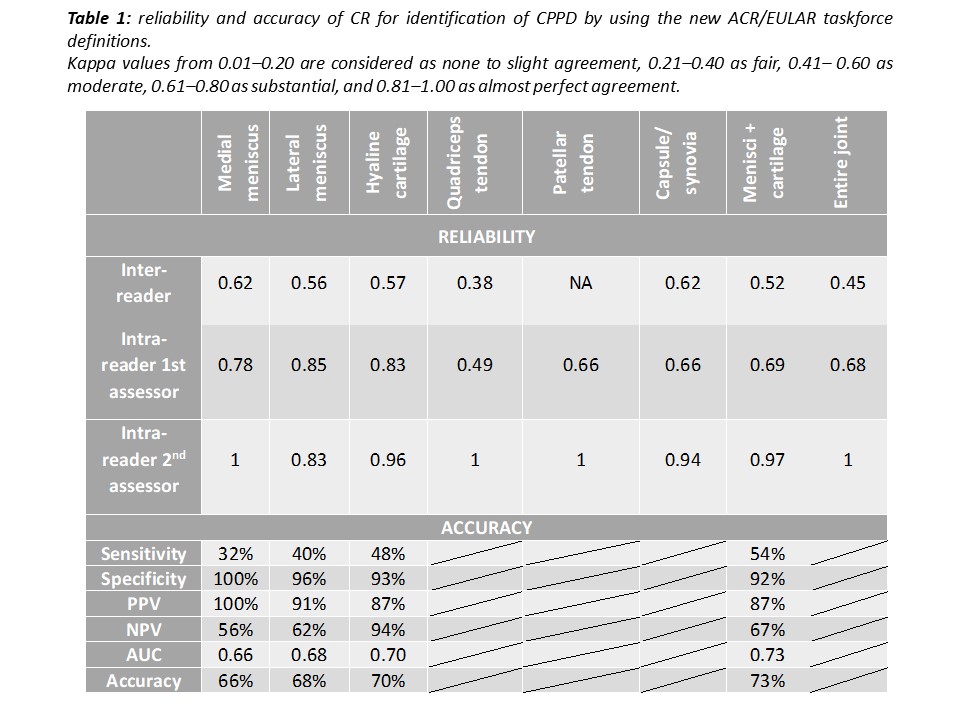Session Information
Date: Tuesday, November 9, 2021
Title: Metabolic & Crystal Arthropathies – Basic & Clinical Science Poster II (1565–1583)
Session Type: Poster Session D
Session Time: 8:30AM-10:30AM
Background/Purpose: Conventional Radiography (CR) has been widely used in Calcium Pyrophosphate Deposition Disease (CPPD) and is considered an important tool for the diagnosis. However, there are very few studies that examine the reliability and the diagnostic accuracy of CR. The aims of this study were to evaluate the diagnostic accuracy of knee CR in CPPD compared to histology and to assess the reliability of CR in CPPD.
Methods: This is an ancillary study of the Criterion Validity of Ultrasound in CPPD study. Consecutive patients with osteoarthritis (OA) awaiting total knee replacement were enrolled in 4 centres. All patients underwent CR of the knees taken maximum 6 months before surgery. DICOM files of the preoperative radiographs were read independently by two radiologists experienced in CPPD for the presence/absence of CPPD at the level of several knee structures. Each reader performed a second evaluation 3 weeks later to calculate the intra-reader agreement. In case of disagreement, for the assessment of accuracy, a consensus decision was taken. The new definitions of the ACR/EULAR taskforce for identification of CPPD in CR were used in this study [paper under submission]: CPPD in CR appears as “linear or punctate opacities in the region of fibro- or hyaline articular cartilage/synovial membrane or joint capsule/within tendons or entheses that are distinct from denser, nummular radio-opaque deposits due to basic calcium phosphate deposition”. Menisci and the hyaline cartilage were analysed as described in the main study. Cohen’s kappa was used to calculate the agreement between the two readers.
Results: 67 patients with OA were enrolled for the reliability study (65% F, mean age 71yo±8) and 51 for the accuracy study (63% F, mean age 74yo±8). For 16 patients not all specimens were retrieved during surgery, so they were excluded from the accuracy study. CR demonstrated to be a specific exam for identification of CPPD at the knee, but sensitivity remains low in all sites and in the overall evaluation (Table1). According to the results of the predictive values, the presence of typical deposition on CR allows a definite confirmation of the diagnosis, but a negative radiography does not exclude CPPD. The k values of the inter- and intra-reader agreement in the various structure are indicated in Table1. Inter-reader agreement was substantial at the level of both menisci but only moderate or fair at the other sites of assessment. On the other hand, intra-reader kappa values were substantial or higher in almost all sites.
Conclusion: The presence of typical CPPD calcifications on CR, according to the definitions of the ACR/EULAR task force, are highly specific but have low sensitivity for disease identification. The low sensitivity found in this study could be due to the advanced grade of OA in the cohort of patients. Furthermore, the difference of the intra-reader compared to the inter-reader kappa values, highlight a different application of the definitions for most of the sites, with the exception of the menisci. For that reason the assessment of calcium crystals at the menisci level should be used for identification of CPPD as other sites of the knee seem to present low reliability.
To cite this abstract in AMA style:
Sirotti S, Becce F, Sconfienza L, Pineda C, Gutierrez M, Serban T, MacCarter D, Adinolfi A, Scanu A, Scire C, Moller I, Naredo E, Sarzi-Puttini P, Abhishek A, Choi H, Dalbeth N, Tedeschi S, D'Agostino M, Damjanov N, Keen H, Terslev L, Iagnocco A, Filippou G. Diagnostic Accuracy and Reliability of Conventional Radiography of the Knee in Calcium Pyrophosphate Deposition Disease by Using New Definitions: An Ancillary Study of the OMERACT Ultrasound – CPPD Group [abstract]. Arthritis Rheumatol. 2021; 73 (suppl 9). https://acrabstracts.org/abstract/diagnostic-accuracy-and-reliability-of-conventional-radiography-of-the-knee-in-calcium-pyrophosphate-deposition-disease-by-using-new-definitions-an-ancillary-study-of-the-omeract-ultrasound/. Accessed .« Back to ACR Convergence 2021
ACR Meeting Abstracts - https://acrabstracts.org/abstract/diagnostic-accuracy-and-reliability-of-conventional-radiography-of-the-knee-in-calcium-pyrophosphate-deposition-disease-by-using-new-definitions-an-ancillary-study-of-the-omeract-ultrasound/

